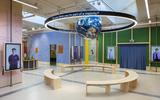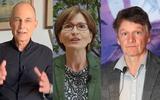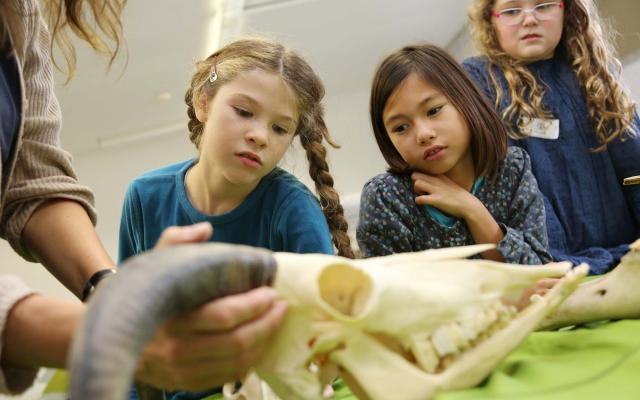Join us on a journey through time! With visually striking displays, the exhibition reveals unusual connections and sharpens our view of the unique spaceship we call Earth, which has been carrying us for millions of years. It highlights the value of fossils as evidence and testimonies of life. After all, it is thanks to research into fossils that we know what we know today. For example, that 300 million years ago swampy forests covered the whole of Europe, providing material for vast coal deposits – the same fossil coal whose combustion now releases huge amounts of CO2 and warms the planet. Or that 250 million years ago, the Earth’s atmosphere was poisoned by gigantic volcanic eruptions. The water in the seas, lakes and rivers became a hostile soup, causing over 80 percent of all animals and plants on land and in the sea to die out. Today, the study of their remains can help teach us lessons about current climate change.
Experiencing Earth’s history
The exhibition lets visitors experience the extent to which humanity and our existence are connected with the history of our planet – from the first traces of life to the distant future. A bleak outlook? Not at all! The exhibition does not gloss over anything, but it does not pay homage to dystopias or threatening scenarios either. It stands for hope rather than powerlessness, and for celebrating the flourishing life on planet Earth rather than lamenting its loss. It aims to encourage reflection and research. Unlike with the natural disasters that have always plagued our planet, we can act to combat anthropogenic global warming. There are numerous measures, innovations and visions with which we can counteract the climate crisis.
Let our guides take you through the exhibition. You can find the dates and registration options here.
How do we bring about changes that benefit everyone? We want to discuss promising ways out of the climate crisis with visitors. Which topic should receive particular attention in the exhibition over the next six months? Which climate and transformation projects are the most promising? At the interactive voting station, visitors can help determine which priorities to set and which ideas to support. Find out more.
Around a dozen people will accompany the exhibition with their presence over many years. They include an IT apprentice, an urban planner and a mountaineer. They report on how they experience the consequences of global warming. How do they feel about it and how have their attitudes, hopes and fears changed over the years? Visitors can listen for themselves on video panels in the exhibition entrance area. A new episode will be added every year.
“Transformations” is a satellite room for the permanent exhibition “Earth, folks! – The changing climate”, which is all about transformation. In a metamorphosis cocoon, visitors can become another living being themselves, touch a crinoid transformed into concrete and connect different perspectives on earthly coexistence. Maja Walter and Giulia Schlüchter – art education students at Bern University of the Arts – invite visitors to broaden their view of our relationships with fellow creatures through sensory perception and reflection. You will find the satellite room by the staircase on the third floor.

Would you like to visit the exhibition with your school class? Various time slots are available for visits. You can register here.
On February 25, 2026, teachers will be given an introduction to our school materials for the exhibition. Further information and the registration form can be found here.
Book private tours and events at the exhibition – please contact the Head of Catering and Events or book the event directly on our website.
With the SBB RailAway offer, you can benefit from discounts on travel and museum admission. Find out more at: https://freizeit.sbb.ch/en/stories/interactive-museum-history-bern
The “Earth, folks!” ambassadors
What do aviation and environmental pioneer Bertrand Piccard, president of Helvetas and former National Councilor (Green Party) Regula Rytz, and cabaret artist and author Christoph Simon have in common? They are all ambassadors for the exhibition. And more will be joining them in the coming months! Our ambassadors explain why they believe the exhibition is important:

Exhibition concept
- Overall management
-
Christoph Beer
- Project management
-
Erich Stettler, Katharina Weistroffer
- Concept
-
Dora Strahm, Ursula Menkveld
- Exhibition curation
-
Dora Strahm
- Scientific curation
-
Ursula Menkveld
- Scenography
-
Christa Held, Alain Rappaport (Rappaport Szenographie Architektur GmbH)
- Visual design
-
Thea Sonderegger
- Lighting concept
-
Claude Hidber (Gradation GmbH)
- Project assistance
-
Zinaida Frosio
- Participation
-
Noemi Scheurer, Eva Grädel
- Steering group
-
Zinaida Frosio, Erika Gobet, Pia Lädrach, Grazia Pergoletti, Fritz Schlunegger
Technology and construction
- Construction management
-
Christian Bähler
- NMBE exhibition building
-
Christian Bähler, Robin Gerber, Stefan Günter, Leonie Haller, Micha Ribeli, Stephan Schlup, Thomas Schmutz, Patrick Wyssmann
- Lighting
-
Gradation GmbH, LG lightguide AG, ERCO Lighting AG
- Flooring
-
Trio Bau AG, Daniel Stern Bodenbeläge
- Electrical installations
-
Gasser & Bertschy Elektro AG
- Graphics production
-
Lettra Design
- Hands-on stations
-
Atelier Lorraine
- Paintwork
-
Burkhard AG
- Media technology
-
Tweaklab AG
- Metal construction
-
Steiner AG
- Joinery
-
Lauclair AG
- Drywall construction
-
Egli AG
Content
- Text and storyboards
-
Dora Strahm, Ursula Menkveld
- Room graphics
-
Fela Bellotto (YK Animation Studio), Thea Sonderegger
- “Living worlds”
-
Illustration: Jana Walczyk, video projection: Georg Lendorff
- “Intro/Outro” animated film
-
Animation: Fela Bellotto, Joder von Rotz, Sebastian Willener (YK Animation Studio), director: Grazia Pergoletti, audio recording: Frank Gerber, narrator: Florentine Krafft
- “Rumor mill” film
-
Director: Grazia Pergoletti, audio recording: Frank Gerber,
shooting and post-production: Tom Bernhard, actress: Gulshan Sheikh, narrators: Meret Matter, Philippe Nauer - Video profiles
-
Noemi Scheurer, Dreh und Postproduktion: Lomotion AG, Interface Design: Robert Huber
- Typography, typesetting
-
Robert Huber
- Infographics
-
Thea Sonderegger, Robert Huber
- Font
-
LL Medium (Lineto GmbH)
- Editing and proofreading
-
Hans-Martin Bürki-Spycher, Christoph Gerber
- Data research support
-
Gina Sommer
- Translations
-
F: Tania Brasseur, E: Jeff Acheson
Objects
- Sources
-
Alfred-Wegener-Institut, alphacam swiss GmbH, Fondation paléontologique jurassienne (FPJ), Roger Ingold (Ingold Gartenbau und Begrünungen AG), M+M Frischpoulet, Hanno Schwarz (3D Atelier), Stiftung Ruhrmuseum Essen, Terreform ONE
- Preparation
-
Gino Bernasconi, Fondation paléontologique jurassienne (FPJ), Micha Häni, Martin Troxler
- Furnishings
-
Gino Bernasconi, Micha Ribeli, Stephan Schlup, Thea Sonderegger, Martin Troxler
Public relations
- Education and mediation
-
Beatrice Baeriswyl, Katharina Lienhard, Andrea Röhrig, Julia Sonderegger
- Marketing and communication
-
Sonja Delz, Stefanie Christ
- Photography
-
Nelly Rodriguez
- Fundraising
-
Stefanie Christ
- Poster
-
Thea Sonderegger, Animation: Daniel Harisberger (Team Tumult)
Scientific advice
- Scientific advice
-
Hubertus Fischer (Klima- und Umweltphysik, Physikalisches Institut, Universität Bern), Erika Gobet (Institut für Pflanzenwissenschaften, Universität Bern), Martin Grosjean (Oeschger Centre for Climate Change Research, Universität Bern), Beda Hofmann, Malte Junge, Michael Moser (UVEK, Bundesamt für Energie BFE), Manuel Schweizer
With the kind support of:
- Verein des Naturhistorischen Museums Bern
- Ursula Wirz Stiftung
- Förderfonds der Berner Kantonalbank BEKB
- GVB Kulturstiftung
- Temperatio
- Ruth & Arthur Scherbarth Stiftung
- and other supporters
Contact for schools and teachers
Contact for private events
Contact for media
- —
Rahmenprogramm «Mensch, Erde! – Das Klima im Wandel»
Ausstellungsführung «Mensch, Erde! – Das Klima im Wandel»
- —
Rahmenprogramm «Mensch, Erde! – Das Klima im Wandel»
Ausstellungsführung «Mensch, Erde! – Das Klima im Wandel»
- —
Rahmenprogramm «Mensch, Erde! – Das Klima im Wandel»





